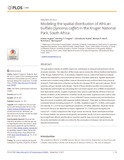JavaScript is disabled for your browser. Some features of this site may not work without it.
| dc.contributor.author | Hughes, Kristen | |
| dc.contributor.author | Fosgate, Geoffrey T. | |
| dc.contributor.author | Budke, Christine M. | |
| dc.contributor.author | Ward, Michael P. | |
| dc.contributor.author | Kerry, Ruth | |
| dc.contributor.author | Ingram, Benjamin R. | |
| dc.date.accessioned | 2018-02-08T16:16:54Z | |
| dc.date.available | 2018-02-08T16:16:54Z | |
| dc.date.issued | 2017-09-13 | |
| dc.identifier.citation | Hughes K, Fosgate GT, Budke CM, et al., (2017) Modeling the spatial distribution of African buffalo (Syncerus caffer) in the Kruger National Park, South Africa, PLoS One, Volume 12, Issue 9, September 2017, Article number e0182903 | en_UK |
| dc.identifier.issn | 1932-6203 | |
| dc.identifier.uri | http://dx.doi.org/10.1371/journal.pone.0182903 | |
| dc.identifier.uri | http://dspace.lib.cranfield.ac.uk/handle/1826/12972 | |
| dc.description.abstract | The population density of wildlife reservoirs contributes to disease transmission risk for domestic animals. The objective of this study was to model the African buffalo distribution of the Kruger National Park. A secondary objective was to collect field data to evaluate models and determine environmental predictors of buffalo detection. Spatial distribution models were created using buffalo census information and archived data from previous research. Field data were collected during the dry (August 2012) and wet (January 2013) seasons using a random walk design. The fit of the prediction models were assessed descriptively and formally by calculating the root mean square error (rMSE) of deviations from field observations. Logistic regression was used to estimate the effects of environmental variables on the detection of buffalo herds and linear regression was used to identify predictors of larger herd sizes. A zero-inflated Poisson model produced distributions that were most consistent with expected buffalo behavior. Field data confirmed that environmental factors including season (P = 0.008), vegetation type (P = 0.002), and vegetation density (P = 0.010) were significant predictors of buffalo detection. Bachelor herds were more likely to be detected in dense vegetation (P = 0.005) and during the wet season (P = 0.022) compared to the larger mixed-sex herds. Static distribution models for African buffalo can produce biologically reasonable results but environmental factors have significant effects and therefore could be used to improve model performance. Accurate distribution models are critical for the evaluation of disease risk and to model disease transmission. | en_UK |
| dc.language.iso | en | en_UK |
| dc.publisher | Public Library of Science | en_UK |
| dc.rights | Attribution 4.0 International | * |
| dc.rights.uri | http://creativecommons.org/licenses/by/4.0/ | * |
| dc.title | Modeling the spatial distribution of African buffalo (Syncerus caffer) in the Kruger National Park, South Africa | en_UK |
| dc.type | Article | en_UK |
Files in this item
The following license files are associated with this item:
This item appears in the following Collection(s)
-
Staff publications (SWEE) [2805]

